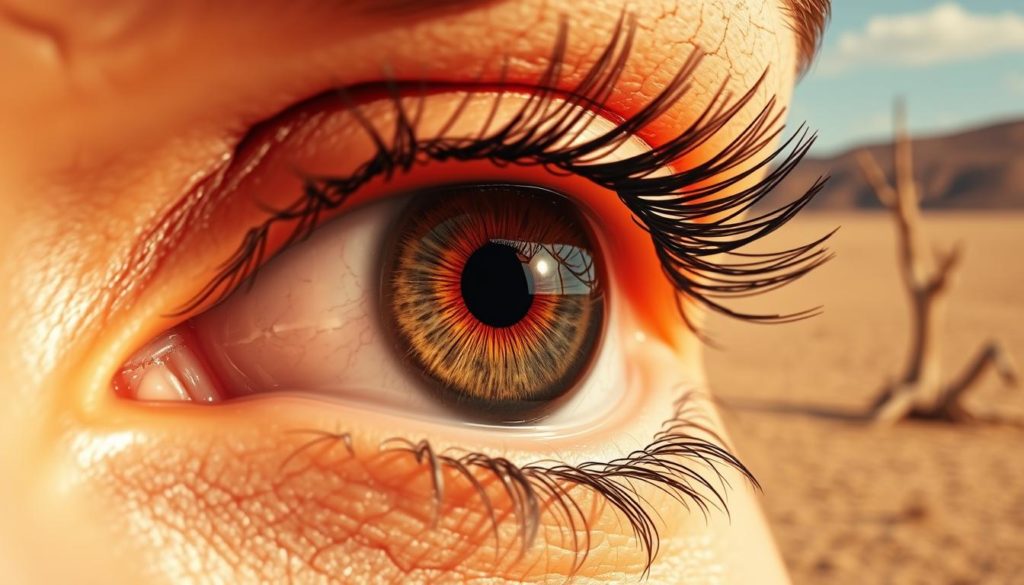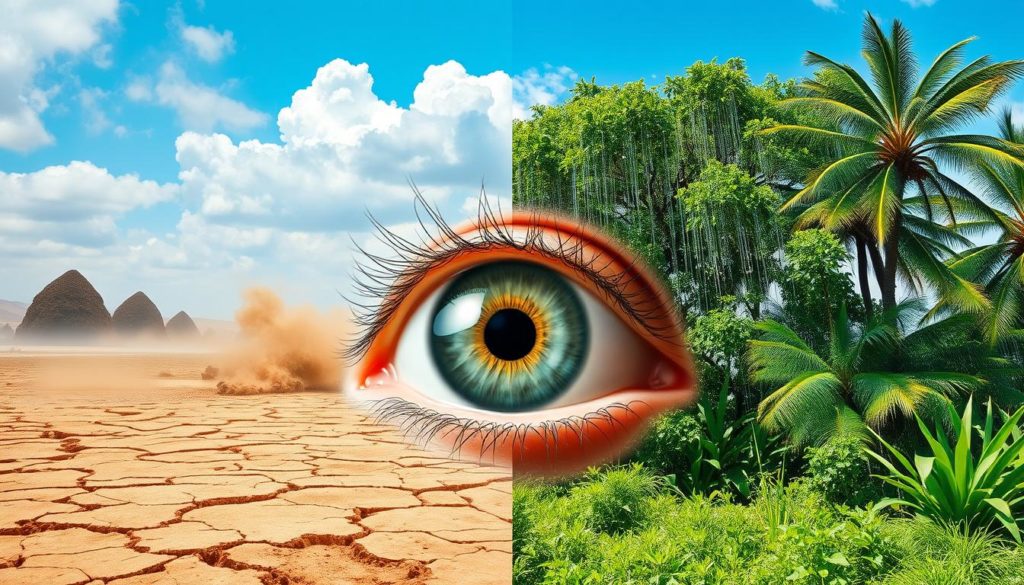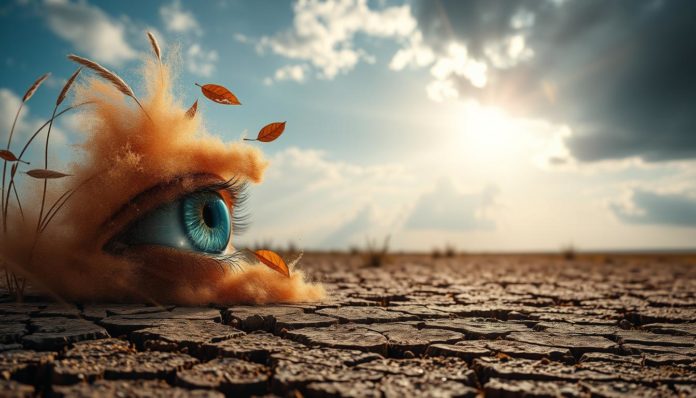Did you know 48% of Americans suffer from dry eye syndrome? Our eye health is really affected by changes in the climate. This makes understanding our environment’s role vital. Eye problems caused by climate are not just annoying during certain seasons. They pose a challenge throughout the year.
The link between climate and dry eye is stronger than many believe. Things like humidity and changes in temperature can make dry eye worse. This leaves our eyes feeling sore and irritated.
But, there’s good news. We can manage dry eye with some effective strategies. This means we can keep our eyes healthy, no matter the weather. Coming up, we’ll see how different climates affect dry eyes. Plus, we’ll share tips to help you deal with these issues. Whether it’s battling dry air in winter or hot temperatures in summer, we’re here to help.
Understanding Dry Eye Syndrome
Dry eye syndrome is a widespread issue affecting many worldwide. It happens when there’s not enough tear production. This leads to eyes feeling uncomfortable and other issues.
Age, hormonal shifts, and certain health problems can increase the risk. The tears’ quality matters too, combining water, oils, mucus, and antibodies to protect the eye.

Problems with tear production can make daily life tough. Symptoms may include a burning feeling, red eyes, and blurry vision. Studies show that pollution and screen time can also worsen dry eye syndrome.
Below is a simple guide on what causes dry eye syndrome and its symptoms:
| Contributors | Symptoms |
|---|---|
| Aging | Redness |
| Hormonal Changes | Burning Sensation |
| Medical Conditions | Blurred Vision |
| Environmental Factors | Dryness |
How Climate Affects Dry Eye
The weather is crucial in making dry eye symptoms worse. It’s important to know how climate affects eye comfort to handle dry eye syndrome.
Humidity Levels
Humidity impacts eye health greatly. When humidity is low, tears evaporate faster, making the tear film break up sooner. On the other hand, moist air keeps eyes lubricated, reducing dryness and discomfort.
Temperature Variations
Temperature changes affect dry eye symptoms. Cold weather can dry out indoor air because of heating, leading to eye discomfort. High heat makes tears evaporate faster, adding to the problem.
Wind Exposure
Wind greatly influences eye dryness. It can quickly reduce the tear film, causing more evaporation and worsening dry eye. Wearing wraparound sunglasses helps lessen this.

Seasonal Changes and Dry Eye Symptoms
Many people feel more discomfort from dry eye when the seasons change, especially because of the weather conditions. The colder seasons like winter and spring can be tough. In winter, the cold air and indoor heaters can make the air dry. This may cause your tears to evaporate faster, making your eyes feel drier.
Spring has its own problems, like more pollen and allergens in the air. These can irritate your eyes and make dry eye symptoms worse. These changes show how much the climate affects our eye health. It’s important to adjust how we take care of our eyes through the year.
Experts, like those from the American Academy of Ophthalmology, have noticed that dry eye symptoms can change with the seasons. They found that issues are often worse in winter and spring. This is because of the weather conditions that are common in these times.
| Season | Common Triggers | Impact on Dry Eye |
|---|---|---|
| Winter | Low Humidity, Wind Chill, Indoor Heating | Increased Tear Evaporation |
| Spring | High Pollen Count, Allergens | Inflamed Ocular Surface |
If we know about these seasonal changes, we can better manage our seasonal dry eye. This can help us feel more comfortable and enjoy life more.
Environmental Factors that Worsen Dry Eye
Dry eye symptoms can worsen due to the environment. Poor air quality, high pollution, and bad indoor air are to blame.
Air Quality
Poor air quality negatively impacts our eyes. Dust, smoke, and irritants in the air can make dry eye worse. Clean, airy spaces are key to reducing these problems.
Regions with low air quality see more dry eye cases. This shows how big an effect the environment has on eye health.
Pollution Levels
Pollution also plays a big role in dry eye issues. Particulates and chemicals from cars irritate our eyes. Cities suffer more because of all the cars and factories.
A recent study found a 20% jump in dry eye symptoms in polluted areas. This shows the link between pollution and eye health.
Indoor Air Conditions
Bad indoor air can also cause problems. Offices often have issues with keeping the air moist enough. Using air purifiers and taking eye breaks helps a lot.
“It’s essential to maintain ideal humidity and air circulation indoors to prevent dry eye.” – American Academy of Ophthalmology
| Factor | Impact on Dry Eye | Mitigation Strategies |
|---|---|---|
| Poor Air Quality | Increases irritants causing dryness | Use air purifiers, ensure good ventilation |
| High Pollution | Irritates eyes, heightening symptoms | Monitor air quality, limit outdoor exposure on high-pollution days |
| Indoor Air Conditions | Low humidity levels exacerbate dry eye | Use humidifiers, take eye breaks |
By understanding these factors and acting early, you can better manage dry eye. This improves comfort and eye health.
Climate and Dry Eye: A Closer Look
The connection between climate and dry eye shows how different seasons affect eye health. Knowing how to deal with dry eye in various seasons is key. This ensures comfort and healthy eyes all year.
Summer
In summer, high temperatures and more UV rays can make dry eye worse. The heat causes tears to evaporate quickly. So, staying hydrated and wearing sunglasses are important to protect your eyes.
Winter
Winter often makes dry eye syndrome severe due to cold winds and heating indoors. These factors lower humidity, which leads to more dryness. Using a humidifier helps keep indoor air moist, which is good for your eyes.
Spring
Spring means more allergens, which can set off dry eye symptoms. Pollen and other irritants affect tear quality, causing discomfort. To ease dry eye in spring, limit allergen exposure and use artificial tears for relief.
Fall
Fall’s changing temperatures and more wind make dry eye challenging. Moving from warm to cool weather affects tear stability. Keeping a steady eye care routine is crucial for dealing with dry eye in fall.
Impact of Urban Living on Dry Eye
The urban living dry eye impact has become a major concern. This is true especially for people living in cities. They face a higher risk of developing dry eye syndrome. Air pollution, which is more common in urban areas, plays a big role in making dry eye symptoms worse.
Air pollutants like ozone and particulate matter are harmful. They are key factors in both causing and worsening dry eye.
Living in cities puts people at a higher risk. This is because they are exposed to pollution for longer periods. This exposure can irritate the eyes. It’s particularly tough for those already struggling with dry eye syndrome.
Indoor air conditioning, common in cities, also affects dry eye. It makes indoor air dry, worsening symptoms. This issue is significant for office workers and city dwellers. They spend a lot of time indoors.
City life is linked to eye health, notably due to the use of air conditioning and heating. These systems decrease indoor humidity. As a result, they can make dry eye problems worse.
It’s vital to improve urban air quality to help with urban living dry eye impact. Raising awareness about how bad air affects eye health is also key. This can help tackle this increasing health issue.
In conclusion, people living in cities need to find ways to deal with air pollution and low humidity. It’s important for protecting their eye health from the city life and eye health challenges.
Common Symptoms of Dry Eye Syndrome
Dry eye syndrome is a condition that affects many people. It can really make daily life hard if not treated early. Recognizing the symptoms is the first step towards getting better.
Redness and Irritation
One key sign of dry eye syndrome is ocular redness. This happens when the eyes don’t make enough tears, or they dry up too fast. This lack of moisture causes redness, a gritty feeling, and irritation.
Blurred Vision
Blurry eyesight is also a big problem for those with dry eye syndrome. It makes simple things like reading, using computers, or driving tough. Constant blurry vision can cause eye strain and headaches.
Light Sensitivity
Being extra sensitive to light or photophobia is another issue for dry eye sufferers. Bright places, whether it’s the sun or indoor lighting, can make the discomfort worse. It makes normal activities challenging.
Here’s a quick look at the common symptoms, what they mean, and how they affect you:
| Symptom | Description | Impact |
|---|---|---|
| Ocular Redness | Red and irritated eyes due to lack of lubrication | Discomfort, social embarrassment |
| Blurry Eyesight | Unclear vision, making tasks cumbersome | Eye strain, headaches |
| Sensitivity to Light | Pain or discomfort in bright environments | Difficulty in outdoor activities, glare-induced discomfort |
Prevention Tips for Managing Dry Eye
To manage dry eye well, you need to change your lifestyle and control your environment. By doing certain things, you can take good care of your eyes and lower the chance of getting dry eyes.
Preventing dry eye starts with following good tips. One key step is to keep the air in your home balanced. A humidifier helps in the winter by keeping the air moist. This stops your eyes from losing water too fast.
It’s also important to rest your eyes Often when you’re doing things that need a lot of focus, like using a computer. The 20-20-20 rule is a good practice. This means looking 20 feet away for 20 seconds every 20 minutes. It helps prevent tired, dry eyes.
Being outside affects your eyes too. Wearing protective glasses, like those that wrap around, can protect your eyes from wind, dust, and the sun’s harmful rays. These are things that can make dry eye worse. Eating foods high in Omega-3 fatty acids also helps. It improves tear production and keeps your eyes healthy.
| Prevention Method | Benefit |
|---|---|
| Using a Humidifier | Increases indoor humidity to reduce tear evaporation. |
| 20-20-20 Rule | Reduces eye strain and fatigue. |
| Protective Eyewear | Shields eyes from wind, dust, and UV rays. |
| Omega-3 Fatty Acids | Boosts natural tear production. |
Putting these management tips into your daily life helps fight dry eye. It also keeps your eyes in great shape. Choose the best strategies for you to keep your eyes comfortable and healthy.
Effective Coping Strategies for Weather-Related Eye Discomfort
When the weather makes dry eyes worse, it’s hard to find comfort. Luckily, there are effective ways to ease this problem. Follow these tips to lessen the discomfort of weather-related dry eyes:
Artificial Tears
Artificial tears are an easy fix for dry eyes. These eye drops add moisture back into your eyes, offering quick relief. Make sure you choose ones without preservatives to prevent irritation with frequent use.
Wraparound Sunglasses
Wraparound sunglasses protect your eyes from wind and dust. These elements can make dry eyes feel worse. This protection is key in windy or dusty conditions.
Using a Humidifier
Dry air inside can make dry eyes worse, especially in winter or dry places. A humidifier keeps the air moist in your home, helping your eyes. It’s really helpful at night to prevent long periods of dryness.
Optimizing Indoor Air Quality
Improving the air inside your home can make your eyes feel better. Use air purifiers, avoid smoke, and dust regularly. These steps reduce irritants in the air, making it better for your eyes. Try these strategies for more comfortable indoor air and relief from dry eye symptoms.
Innovative Treatments for Dry Eye
Ocular health has come a long way. Now, there are many effective treatments for dry eye syndrome. These treatments tackle the main cause of dry eyes. They provide big relief and make life better for patients.
Equinox Low-Level Light Treatment (LLLT)
LLLT is a modern therapy that uses gentle light. It boosts oil production in the meibomian gland. This action helps improve the tear film, easing dry eye symptoms. The process is safe, not invasive, and works well for long-term dry eye.
Lumenis Optilight Intense Pulsed Light (IPL) Therapy
IPL Therapy is made for eye surface diseases. It sends light pulses to lessen inflammation and better gland function. Research shows IPL therapy noticeably reduces dry eye issues. It also makes tears more stable over time.
TearCare
TearCare introduces a wearable device that gently heats the eyelids. This melts the meibum, improving gland expression. It’s particularly good for those with gland problems. TearCare offers a hands-free, effective way to fight dry eye discomfort.
LipiFlow®
LipiFlow® uniquely blends heat and mild pressure to unblock meibomian glands. This method boosts the eye’s natural oil flow, easing evaporative dry eye. Users often see a real improvement in eye comfort and seeing clearly.
When to Seek Professional Help
Feeling dry eyes from time to time is common and usually fixable with simple solutions and changes in lifestyle. But if these problems don’t go away or get worse, it’s important to get professional help. This is because ongoing dryness, non-stop irritation, or big changes in how well you can see might be signs of a more serious problem that needs the right diagnosis and treatment.
Knowing when to get help for dry eye is key to keeping your eyes healthy. Don’t ignore signs like lasting redness, endless itching, or vision that stays blurry. Seeing an eye care expert means you’ll get checked out fully and find out about better treatment options if you need them.
Getting professional help means they look at everything, not just the symptoms you’re having. Eye specialists can figure out why you have dry eye, whether it’s from the air around you, health issues, or the medicine you’re taking. Getting help early can reduce discomfort and stop other eye problems before they start affecting your sight more.
Making your eye health a priority by getting treatment for dry eye means you’ll get advice and treatments that match what you specifically need. Whether it needs special treatments, medicine, or changing some habits, getting help from experts is key. They help you deal with dry eye syndrome in the best way possible.
FAQ
How does climate affect the severity of dry eye symptoms?
Climate has a big impact on dry eye symptoms. Changes in humidity, temperature, and wind can make tears evaporate faster. For example, low humidity makes tears dry up quicker. High winds can also make eyes drier.
Different weather conditions, like winter cold and spring allergens, can make dry eye worse.
What are the common symptoms of dry eye syndrome?
Dry eye syndrome can make your eyes red, irritated, and blurry. You might also be sensitive to light. These issues can make everyday tasks hard and lower your life quality. It’s important to deal with these symptoms to keep your eyes healthy.
How can I prevent dry eye syndrome despite environmental factors?
To prevent dry eye, you can make changes in your lifestyle and environment. Use artificial tears, wear wraparound sunglasses, and use a humidifier to keep the air moist. Drinking water and taking screen breaks are also good for your eyes.
What environmental factors worsen dry eye syndrome?
Bad air quality and pollution, especially indoors, can make dry eye worse. Pollutants make your tear film less stable. Air conditioning can dry out the air, making tears evaporate faster.
How do seasonal changes influence dry eye symptoms?
Seasonal changes really affect dry eye symptoms. In winter, cold air and wind raise tear evaporation, and heaters dry out the air. In spring, allergens trigger symptoms. But, summer’s humidity might help, depending on how sensitive you are.
What advanced treatments are available for dry eye syndrome?
For dry eye, there are treatments like Low-Level Light Treatment (LLLT), Intense Pulsed Light (IPL) Therapy, TearCare, and LipiFlow®. They aim at different dry eye causes, like meibomian gland issues, by making the tear film better and lowering inflammation. An eye doctor can help pick the right treatment for you.
Why is urban living associated with higher rates of dry eye?
Urban living can lead to more dry eye because of the pollution and bad indoor air. Cities have more pollutants that mess with the tear film. Using air conditioning and heating a lot in cities also dries out the air, causing more tear evaporation.
When should I seek professional help for dry eye symptoms?
You should see a professional if dry eye symptoms don’t go away or are really bad. They can mess with your daily life. An eye care expert can check your eyes closely, figure out the cause, and suggest the best treatments.
How do humidity levels affect dry eye syndrome?
Humidity levels are very important for dry eye syndrome. Low humidity makes tears dry faster, leading to dry eyes. On the other hand, high humidity keeps the eyes moist, easing symptoms. Managing indoor humidity is key to controlling dry eye.


